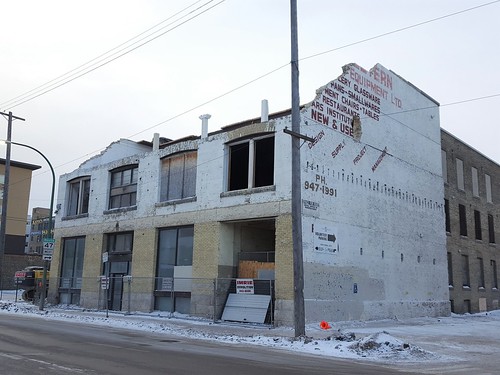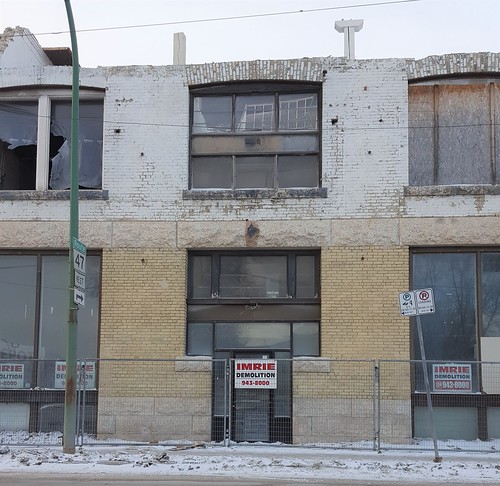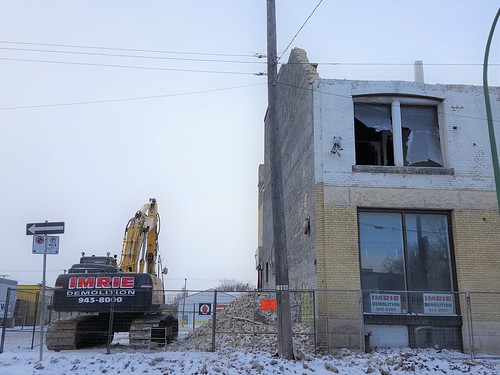December 24, 2017
Place: 288 Princess Street
Constructed: 1904-05
Size: Three storeys, 24,000 square feet
Architect: Darling and Pearson
Contractors: Saul and Irish /J McDiarmid
This building is currently being demolished as part of an eventual expansion of Siloam Mission.
February 4, 1905, Winnipeg Free Press
It was built for the Ideal Bedding Company of Toronto. Construction began in October 1904 and it was ready for occupancy by the beginning of January.
The architects were Darling and Pearson of Toronto, who would go on to design many of our city's iconic buildings, including the Bank of Nova Scotia, Bank of Commerce / Millennium Centre, Union Bank Tower and the Grain Exchange Building III. The contractors were Saul & Irish and J. McDiarmid Co.
Initially, the building was two storeys tall but had an over-engineered foundation and 26-inch thick walls so that two more storeys could be added at a future date. One more storey was added, likely the following spring.
1905 Henderson Directory
In 1910, Ideal moved to new premises. The building was subdivided and a number of short term tenants called it home. They included the Winnipeg Warehousing Co., Williams Manufacturing Co., Quaker Oats Co., and Herman Raw Fur Co..
After the bankruptcy of Herman's in 1930, it appears the building sat empty through the Depression. In 1938, ads appeared in the newspapers offering it and another warehouse on Henry Street for sale "for wrecking purposes or otherwise".
288 Princess Street got a new lease on life when it was resold to Winnipeg Cabinet Factory as their new home. The company had been in operation since at least 1905 providing custom-built residential and commercial cabinets.
Shortly before moving, the company expanded into the sale of mainly used store and restaurant fixtures, everything from stools to soda fountains. That aspect of its business appears to have expanded greatly after their relocation .
Winnipeg Cabinet Factory went out of business in 1962.
Top: October 9, 1969
Bottom: June 19, 1975
In 1963, the building became home to Wholesale Furniture Mart which had operated in the city for around four decades further up on Princess Street.
Soon after the owner died, the business closed and its contents put up for auction. Former employee Fred Brick and his wife Cynthia bought out the lease and reopened the store as Brick's Wholesale Furniture House.
The Bricks soon changed the focus to deal in higher -nd merchandise and in the early 1970s the store was renamed Brick's Fine Furniture.
In 1976, Brick's Find Furniture moved to 111 Lombard Avenue, where they remained until 2008. They are now located at 171 Bannatyne Avenue. (For more on the history of Brick's Fine Furniture.)
September 19, 1981, Winnipeg Free Press
In 1981, 288 Princess became home to Western Restaurant Supply Ltd.
Created by Asher Rosenberg in 1971, it designed and supplied commercial kitchens for restaurants and institutions. Their expanded home at 288 Princess allowed them to open to the public selling new and used restaurant equipment and supplies.
Western had a number of ups and downs. In 1983, by that time run by son Lionel, it went into receivership but was restructured under the same ownership as Westwin Food Equipment Ltd.
Another financial crisis in 1996 saw the company shrink down to just a handful of employees and its share of the local market hovered at just around 10 - 15% with their major competitor being Cassidy's.
When Cassidy's went into receivership in 2000, the company took advantage and hired a number of its former employees and expanded its lines and territory.
The company last advertised in 2009 and closed down ca. 2010.
Top: Westwin, left, and Siloam, right. (Google Maps)
Bottom: Minutes, Mar. 15, 2016 EPC Meeting (Source)
In February 2010 neighbouring Siloam Mission purchased the building as part of a future expansion plan and temporarily moved some programming into the space.
In 2016, Siloam received a heritage review they requested from the city's Historical Buildings and Resources Committee about their plans. The HRDC noted that 288 Princess was not a protected building but requested that they: "explore the possibility of adaptively re-purposing and integrating the building into their expansion plans."
Demolition began in December 2017.












There won't be much left of this area if it continues. I look around and it's just a blotchy landscape of some heritage buildings, and bland new structures that have no features except metal and glass, or exposed concrete.
ReplyDelete